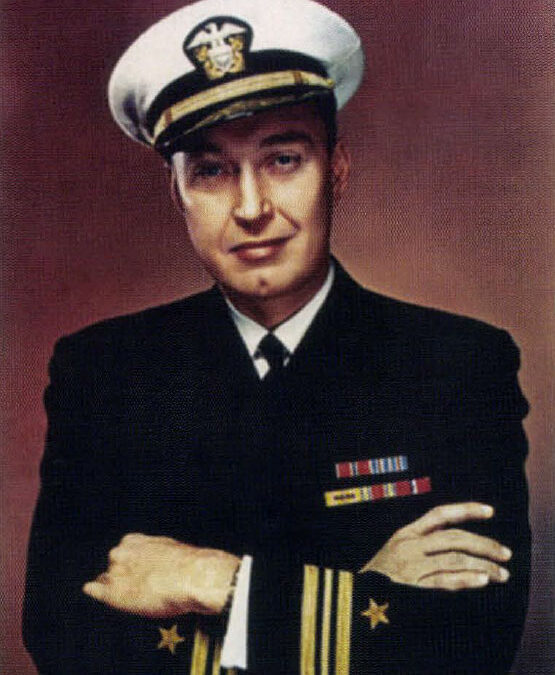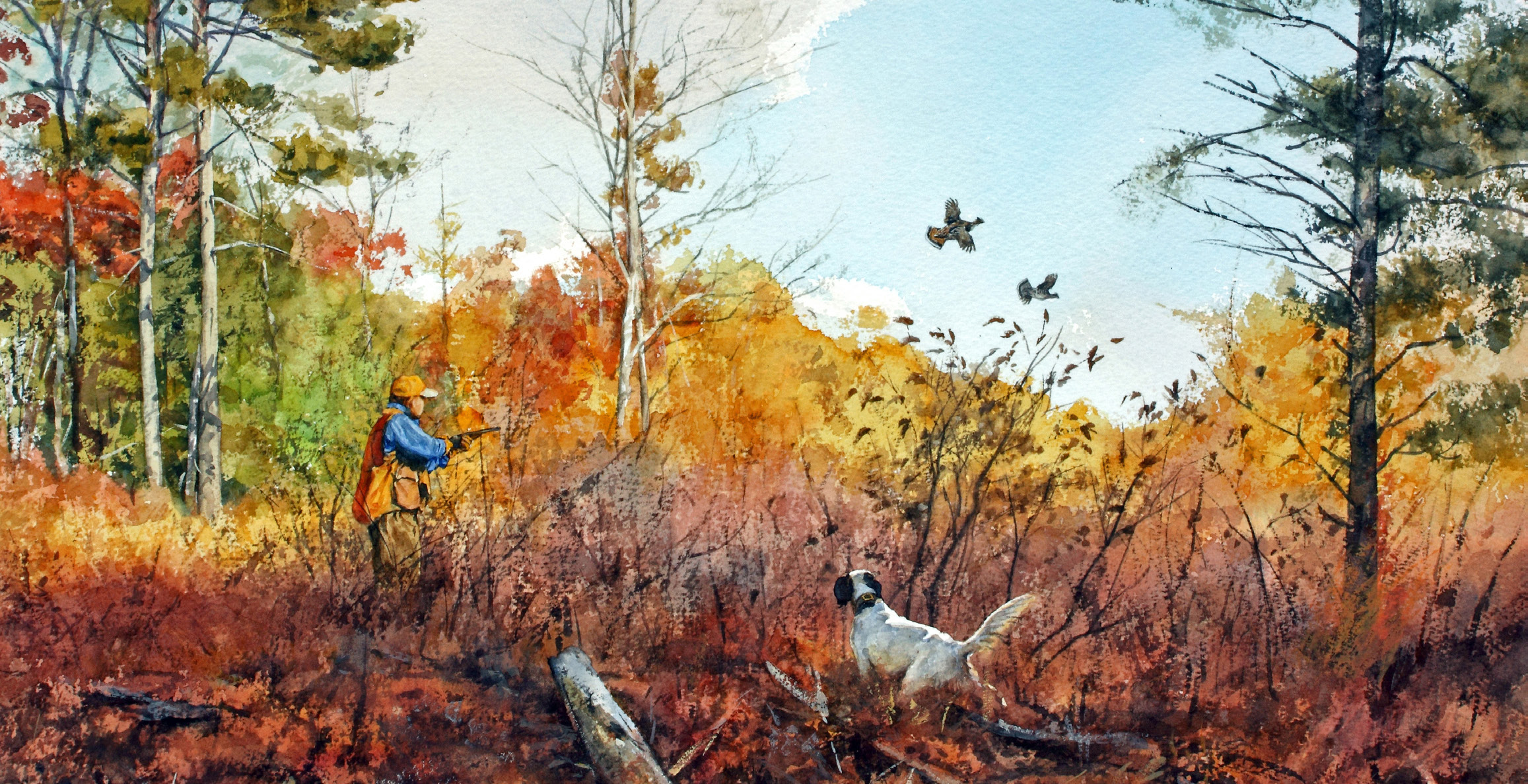He was a rambling boy. They called him Kid Carolina.
Dick Reynolds, officially Robert Joshua Reynolds Jr., born to wealth and privilege. He was the eldest son of the North Carolina tobacco magnate of the same name, the creator of Prince Albert pipe tobacco and Camel cigarettes, the world’s first “tailormade” smokes . The early death of both his parents left Dick an orphan at 17 — with a $100,000 a year allowance, but no discipline or direction whatsoever. It was a bad combination. His brother, Z. Smith Reynolds, got the same deal, but he died of a gunshot wound to the head, self-inflicted or murdered, nobody knows for sure. His wife, his lawyer, or maybe both? The cops puzzled a good long while but finally dropped the investigation at the family’s request.
Young Dick Reynolds helped make the Twenties roar. He ran away to sea under an assumed name aboard a tramp steamer bound for Hamburg. He was discovered and sent back home. He hung out at spendy nightclubs in Europe and New York. He sponsored a Broadway play just to get into showgirls’ britches and he got into plenty. He bought them jewelry and cars. He bought himself an airplane and had his pilot’s license Signed by none other than Orville Wright.
A hundred grand a year would go a long way in 1929.
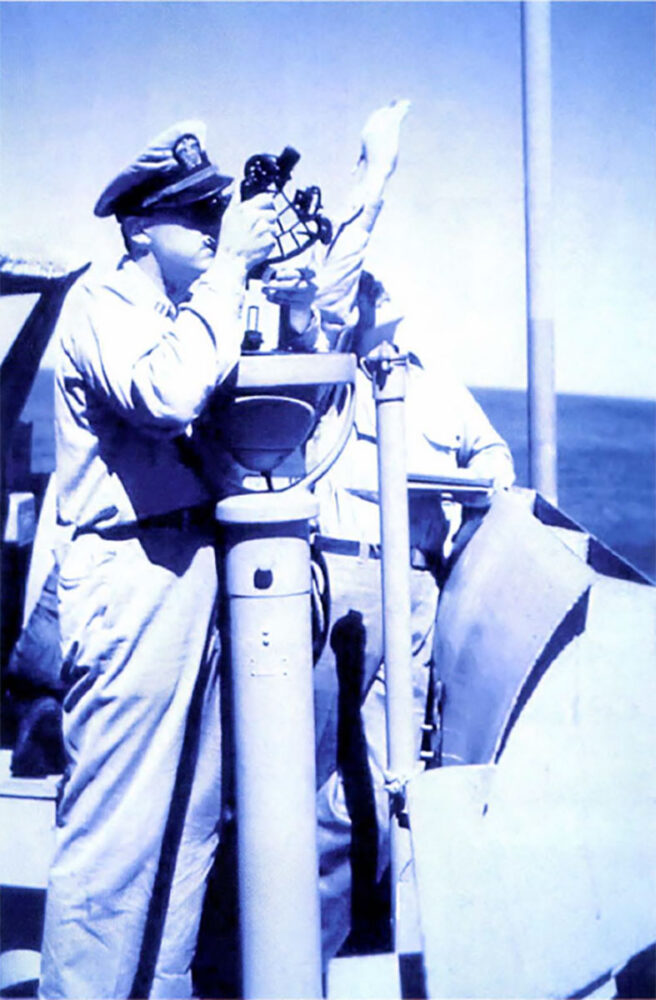
Reynolds on the bridge of the USS Makin Island, an escort carrier on which he won a Bronze Star.
In his will, R. J. Senior denied Bad Boy’s full inheritance until he turned 28, figuring he’d have good sense by then. Maybe not. By the time Junior got his $25 million and became the richest man in America, he had been married twice, divorced once and had cultivated a serious drinking problem. Driving drunk, he ran over and killed a bicyclist in England, an offense which landed him in jail for only five months, thanks to the best efforts of his big-buck American lawyers. And he chain-smoked his own Camel cigarettes, free of course.
Meanwhile, Dick created Reynolds Airlines, which later became Piedmont and then part of US Air. He invested heavily in Eastern Airlines and took an obscure crop-dusting business, Delta, into history. He bought an 1800-ton steamship, converted it to an ocean-going yacht, and took to sea once again, but the crew mutinied, put him ashore in West Africa and chained him to a tree until he got over his delirium tremens.
Recovering mostly, he single-handedly financed FDR’s third election campaign and years later Harry Truman’s first full term. He got elected mayor of Winston Salem, built public parks and affordable housing for the city’s poor, but resigned to serve as navigation officer on the USS Makin Island, an escort carrier in the Pacific during WWII.
Lt. Commander Richard J. Reynolds’ naval service was exemplary, despite the whiskey he smuggled on board. But Dick was well versed in navigating drunk. Three times he brought Makin Island into combat, and dodging kamikazes, he brought her out again without even a bullet hole. Makin Island got a Presidential Unit citation, and Reynolds won a Bronze Star.
But Sapelo, this golden island in the sun, his beloved enclave on the Georgia coast, was his most enduring legacy.
Sapelo was a Spanish mission in the 1500s, SanJuan de Zapala, but the locals, primarily Geechee Negroes from Sierra Leone, could not wrap their tongues around the lingo. Sapelo was the best they could do and the island, 18,000 acres halfway between Savannah and Jacksonville, remains Sapelo to this day.
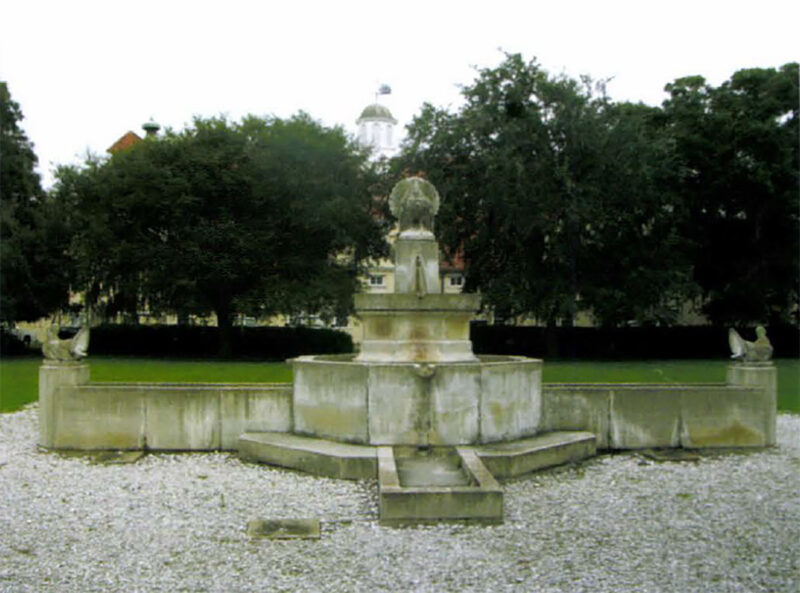
Reynolds tried but failed to blow up these concrete turkeys on the Sapelo grounds.
Sapelo was the early domain of William Spaulding, a rock-ribbed old Calvinist who hated cards, dancing and music, but who treated his slaves so kindly that neighbors dubbed the island “n—er heaven.” So great was his confidence in his Geechees that Spaulding requested, and amazingly received, muskets from the state arsenal to arm them against an expected British invasion during the War of 1812. British sympathizers got the word, passed it along to the Royal Marines who wanted no part of Spaulding’s fearsome barefooted slave militia.
After the Civil War swept away the old regime, Sapelo was purchased by Howard Coffin, vice-president of the Hudson Motor Car Company, an original partner in United Airlines, who turned the island into a world-class sporting retreat. Deer, ducks, pheasants, wild turkey, boar, quail? Sapelo had it all. Coffin even introduced chachalacas, a pheasant-sized gamebird from Guatemala, which is still found on the island today.
Charles Lindberg landed his airplane on the beach, ditto Amelia Earhart. Henry Ford was a regular visitor. Presidents Calvin Coolidge and Herbert Hoover and their respective First Ladies spent Christmases there. But Coffin had more ambition than good sense. After his attempt to build the famed Cloister Resort on nearby Sea Island faltered, he turned to Dick Reynolds to bail him out.
Drunk or sober, Dick Reynolds was too small to cut a check to support the Cloister. Reynolds knew Coffin paid a little more than eight dollars per acre for Sapelo in 1912. Yes, Coffin had made considerable improvements: duck impoundments, quail habitat, stocking birds, building docks and landings, an opulent mansion atop the ruins of Spaulding’s plantation house, clearing land for an airstrip that remains the longest grass runway on the East Coast. But times were tough and Coffin was in a bind.
Reynolds offered $750,000. Coffin choked, gagged, sagged, but had little choice. The Cloister ate up the three-quarter million soon enough and Coffin sank into a deep depression from which he never recovered. His death two years later was officially ruled “accidental,” but folks still wonder.
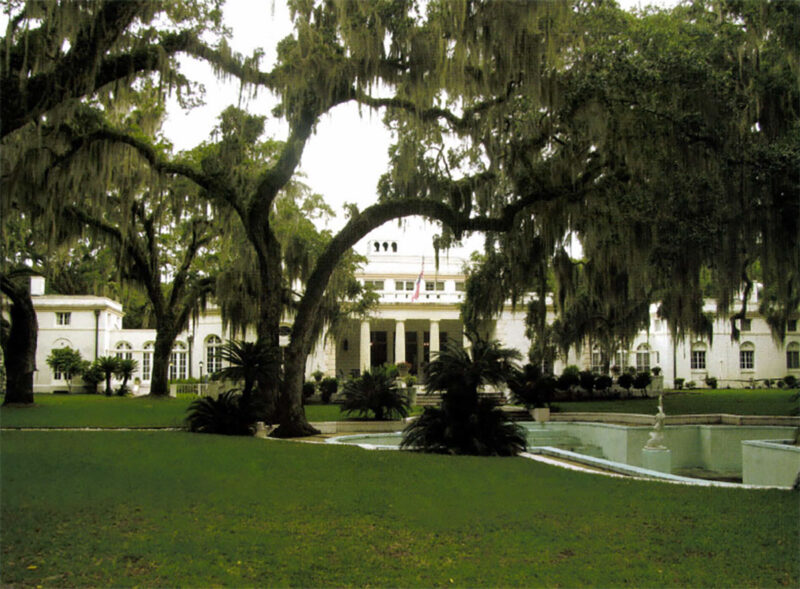
The mansion and grounds at Sapelo are a sub-tropical wonderment, a time bubble, virtually unchanged from when Dick Reynold lived there.
Though Reynolds traveled the world by air, land and sea, Sapelo would remain his legal residence — and spiritual home — for 30 years. He divorced Wife Two, married Wife Three in the Big House garden. He took her on a couple of cruises, but then left her on Sapelo and returned to sea again aboard a sailing yacht he had custom built by a British shipyard. The missus — high-toned and bored Muriel Maud Marston Laurence Reynolds — turned to voodoo, burning candles and incense, consulting with spiritualists. She dug a series of landscaped ponds, each resembling one of the seven seas. It was like Penelope weaving the tapestry in the Odyssey, as if those ponds would somehow bring her husband home. She also built a new fountain behind the big house, each corner anchored by a monstrous concrete wild turkey.
Dick Reynolds came home like Odysseus finally did, but instead of slaying his wife’s suitors with a bow, to a storage shed and fetched up a case of dynamite, intending to blow the turkeys all to hell.
The explosion blew all the windows out of the barn. Uninvited quests cleared out quickly but the concrete turkeys could not run and they remain to this day, unscathed, the subject of continuing commentary. Muriel’s ponds have all gone back to wild swamp, the lair of alligators and cotton-mouth snakes.
Yes, he was a bad boy. But Dick Reynolds was a good boy too. After repeated warnings from his doctors about his impending doom, in 1947 he turned the south third of Sapelo over to a non-profit, The Sapelo Island Foundation, made it available to the University of Georgia for a marine research station and provided enough money to fund a department to run it.
It was a Godsend to a land-locked institution in Athens, Georgia, 200-plus miles from the sea. The dairy barn — with replaced windows — became a laboratory and the upstairs hayloft, originally an air-conditioned movie theatre for employees and guests, began showing educational documentaries.
Dick Reynolds suspected, and subsequent Georgia research confirmed, the vast spartina marsh flats between Sapelo and the mainland were the source of all marine life between high ground and the Continental shelf; indeed, just as it was across the entire southeast coast where the booming flood tide inundated so much real estate.
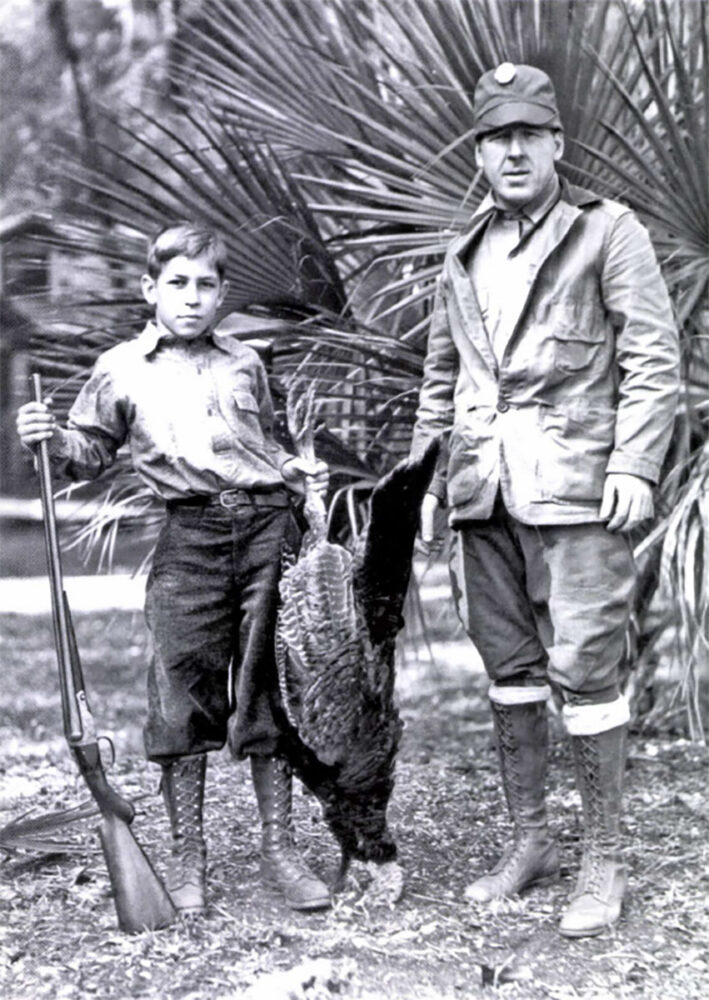
Eliott White Springs and Sonny killed this big gobbler at Sapelo in the early ’50s. A World War I ace and textile magnate, White Springs was one of many celebrities and politicians who hunted on the estate.
All the shrimping and fishing, both commercial and recreational, were dependent on nutrients from these salt marshes. But bow this happened, and why, remained a mystery. How deep was the mud? How old was the mud? What nutrients did the marsh create, and what were the chemical and biological processes? How did it get offshore? And if inshore, near-shore and offshore life was dependent on a healthy salt-marsh, what could be done to protect it well into the future?
Enter internationally famous Eugene Odum, University of Georgia professor, literally the inventor of the modern concept of ecology. Author of more thana dozen books, including the groundbreaking Fundamentals of Ecology, Odum ran the Sap 10marine lab for 40 years, even coming to work daily after his official retirement in 1984.
Dick Reynolds worked with Odum to secure funding from the National Science Foundation in 1958 to bring scientists from the Netherlands to New Zeal and to Sapelo for the Salt Marsh Conference, this first of its kind. And they all helped unravel the secrets of the marsh, an ongoing process.
But meanwhile, there was trouble at home, as you might expect. Dick worried excessively about the stability of the stock market. In those days, it was illegal for Americans to board gold. But Dick smuggled it in from Europe aboard his yacht, buried sacks of it here and there in the Sapelo woods. He later retrieved it, but maybe not all.
In a bout of paranoid delusion, he burned paperwork associated with his tenure on Sapelo —financial statements, employee records, photographs, everything he could lay his hands on, more precious than gold to those who would someday want to celebrate his achievements.
On one of his European jaunts, Dick met Annemarie Schmitt, a Swiss native with a PhD in Philosophy, nearly 30 years his junior. His subsequent divorce from Muriel was contested in Darien, Georgia, before a jury, appealed there and in Atlanta, public proceedings providing titillating details of the couple’s raucous private life and outrageous fortune. Astounded locals shook their heads for a decade.
Finally shut of court, Dick Reynolds and Annemarie retreated to Switzerland where he spent his final years far from the sea he loved. By then Dick had developed severe emphysema and was spending his nights in an oxygen tent. He died on December 14, 1964 of “an oxygen overdose.”
When his un-witnessed will was probated, it left his entire estate, $25 million in cash, unaccounted gold bullion, and the remaining 9,000 Sapelo acres to Annemarie.
The Reynolds family, including wives two and three, cried foul. Who ever heard of an oxygen overdose? Even though legal in the Swiss canton where they were filed, why were there no witnesses to either the marriage or the will? Did Annemarie lure an ailing Dick Reynolds there for that purpose?
The family hired private detectives and attempted to open a murder investigation. When that failed, they filed a Wrongful Death suit, which fared no better. In two transactions, in 1969 and 1976, Annemarie deeded the remainder of Sapelo to the State of Georgia. Governor Jimmy Carter, himself a hunter and conservationist, graciously accepted that second donation.
Today, Sapelo is a sub-tropical wonderment, a time bubble, remaining much as Dick Reynolds left it. The big house is a bed and breakfast now that sleeps 28, run by the state, staffed by the grandchildren of Reynolds’ hired hands. The outbuildings, converted to labs and dormitories for visiting students in the marine sciences, retain their original appearance. The bombproof concrete wild turkeys still grace the backyard fountain. After 200 years, descendants of John Spalding’s Geechee slaves still cling to their 435-acre enclave, Hog Hammock.
If you care about hunting, Fishing, history, natural beauty, wildlife, coastal ecology or culture, you would enjoy your visit to Sapelo. But you can’t just show up at the ferry landing. You have to be invited.
Sapelo is as private as in Reynolds’ day. If you book a tour, your guide extends the invitation. If you wish to visit the UGA Marine Science facility, you will need a good reason. The Georgia DNR runs the ferry from Meridian and they scrutinize the passenger manifest. But rent the South End house, abode of Spaulding, Coffin and Reynolds, for a reunion or wedding? You are good to go. Ditto if you want to hunt.
Sapelo is open for public deer, hog, dove and small game hunting, as the northern half of the island is a state wildlife management area. There is an exclusionary “safety zone” around Hog Hammock, and it’s archery only around the Institute on the south end.
Fishing in the waters surrounding Sapelo is world class, as you might expect in a place so closely protected. Sea trout and redfish on salt marsh edges in the fall, 50-pound cobia around buoys and jetties in May and June, sheepshead beneath the docks year-round.
Gray’s Reef, just 17 miles offshore, at 14 square miles, is the second largest and closest live bottom reef on the East Coast. Besides the typical bottom fish, snapper and grouper and such, cobia hang out there prior and after their inshore spawning run, and pelagic fish, especially king mackerel, chainsaw their way though great clouds of baitfish. Gray’s Reef is a National Marine Sanctuary. Catch and release is encouraged for bottom fish but not currently mandatory.
So what can we say about Robert Joshua Reynolds, Jr., the rambling boy? What’s the final tally? He inherited $28 million. He spent, he wasted, he paid off x-wives, he invested, he gave money away. Yet 30-odd years later, he still had his $28 million. Add his charitable donations to those of his mother, father, sister and brother, assorted nieces and nephews, the Reynolds family has given away nearly a billion dollars. For a man who took such good care of strangers, it is a shame he did not take better care of himself.
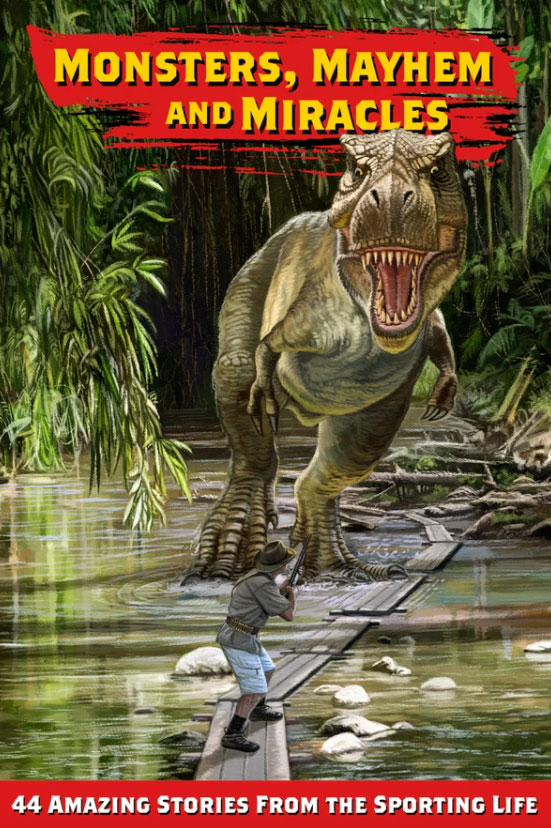 Truly a first in the world of outdoor publishing, Monsters, Mayhem and Miracles is a one-of-a-kind collection of unforgettable tales from the sporting world. Its 44 stories range from harrowing encounters with deadly predators to astonishing tales involving spirits, ghosts and even the devil himself. Buy Now
Truly a first in the world of outdoor publishing, Monsters, Mayhem and Miracles is a one-of-a-kind collection of unforgettable tales from the sporting world. Its 44 stories range from harrowing encounters with deadly predators to astonishing tales involving spirits, ghosts and even the devil himself. Buy Now

